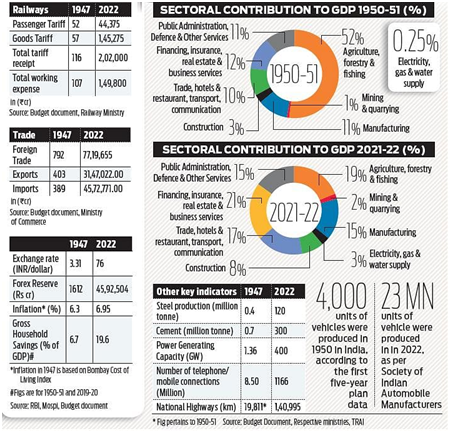

Context
August 15, 2022 marked 75 years of our country’s Independence and of its economy as a self-managed one. In its advancements since, the economy changed structure and evolved with many successes as well as failings.
- This brief aims to analyse an overview of how Indian economy has come through over the last 75 years.
Background
- India was classified as a ‘third-world’ country at the time of Independence from British rule in 1947.
- But over the past seven decades, its GDP has grown from just Rs 2.7 lakh crore to Rs 150 lakh crore.
- The nation weathered many crises to be ranked among the biggest economies of the world and the fastest growing major economy on the planet.
Analysis
What is the current status?
- Energy security: The country is addressing energy security by increasing focus on renewable sources, biofuels and hydrogen, it is promoting domestic manufacturing through schemes such as PLI that provide Rs 1 lakh crore of incentives to local production units.
- Digitalisation (India’s techade): The Digital India Movement with the production of semiconductors, 5G networks, and optical fibre networks show has shown great results in education, healthcare and changes in common man’s lives.
India's Socio-Economic Trajectory
|
Gross Domestic Product (GDP)
|
|
|
Per Capital Net National Income
|
|
|
Total Revenue
|
Rose from ? 171.15 crore in 1947-48 to ? 20,78,936 crore in 2021-22, as per this year's Budget revised estimates. |
|
Forex Reserves
|
|
|
Foreign Trade
|
|
|
Foodgrain production
|
|
|
Literacy rate
|
|
|
Sex Ratio
|
|


Important Events during the journey
- Planning Commission & FYPs: India set up the Planning Commission in 1950 in order to oversee the entire range of planning, including resource allocation, implementation and appraisal of five-year plans (FYPs).
- Nationalisation: From 50s to 91, several industries, companies were nationalised by the government.
- Nationalised airlines—Air India, Air Services of India, Airways (India), Bharat Airways, Deccan Airways, Himalayan Aviation, Indian National Airways, Kalinga Airlines, and the Air India International
- In 1969, 14 leading banks were nationalized on July 19, 1969.
- Liberalisation: The Narasimha Rao government, including then Finance Minister Manmohan Singh, initiated economic reforms in 1991. These reforms aimed to liberalise the economy by doing away with the Licence Raj.
- Demonetisation & GST: Two of the most talked about economic events in the 21st century are Demonetisation and Good & Services Tax (GST).
What are the urgent challenges that need to be taken care of?
The urgent challenges are as given below:
Unemployment
- India’s overall unemployment rate is estimated to be between 8-10%; only 49% of working age population participates in the labour force compared to Bangladesh’s 59% and China’s 68%, while female labour force participation has been consistently declining to just 26%.
- Informal employment dominates (almost 90%) with low pay and lack of social security; a worrying slip back to agriculture from services and manufacturing has been observed in the last few years.
Income inequality
- Income inequality has steadily mounted in the past three decades.
- The Gini index, which measures the distance from a perfectly equal distribution (0) and extreme inequality(100) in the distribution of income (in India’s case, consumption expenditure) among individuals or households, was reported at 35.7 in 2011 (31.7% in 1993), the last year when consumer expenditure was surveyed.
Climate Change
- A challenge that will continuously evolve to the forefront will be tackling climate change. India is amongst the most vulnerable countries and the costs of climate change, be these from pollution or the increased frequency of extreme weather events, have rapidly escalated. The commitment to a net zero carbon emissions economy by 2070 will require significant effort, resources and planning.



